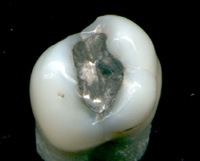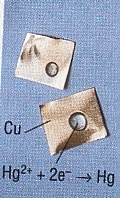amalgam
An amalgam ( ancient Greek μαλακός malakos 'soft' with alpha privativum , i.e. the 'non-softening'; according to another etymology Arabic al malagma ' emollient ointment', or al-magam from Greek málagma ) is an alloy of mercury in chemistry . Amalgam in the broader sense is also often used to denote non-reversible mixtures of other substances, usually the alloy of several metals. In a figurative sense, amalgam is also a mixture of different terms, ideas, cultures or traditions.
Since many metals are soluble in mercury, there are many amalgams. Some metals such as iron are not amalgam formers. Amalgams with a high mercury content are often liquid like mercury itself at room temperature ; if the mercury content is lower, they are solid.
In classical alchemy , the amalgamation ("coagulation") of mercury with other metals is often compared with physical union. As alchemical lexeme is the medieval Latin amalgama occupied since the 13th century.
Natural amalgams

Several naturally occurring amalgams are known and recognized by the International Mineralogical Association as minerals in their own right:
- With lead: lead amalgam (Pb 2 Hg)
- With copper: Belendorffit (Cu 7 Hg 6 ), Kolymite (Cu 7 Hg 6 )
- With palladium: Potarit (PdHg)
- With silver: eugenite (Ag 11 Hg 2 ), luanheit (Ag 3 Hg), moschellandsbergite (Ag 2 Hg 3 ), paraschachnerite (Ag 1.2 Hg 0.8 ), schachnerite (Ag 1.1 Hg 0.9 )
- With silver and gold: Weishanite ((Au, Ag) 3 Hg 2 )
Technical amalgams and their uses
Dental amalgam
In dentistry, an alloy of mercury with other metals such as silver, copper, indium, tin and zinc is used extensively as a tooth filling material. A connection with serious health problems could not be proven. There is minimal mercury exposure.
Sodium amalgam
A technically important reducing agent in organic and inorganic chemistry and amalgam produced on a large scale is sodium amalgam , which is formed as an intermediate product in chlor-alkali electrolysis . It is decomposed with water to form caustic soda , hydrogen and mercury , which is reused for electrolysis in the circuit .
Ammonium amalgam
Since the alkali metals form amalgams, for example during the electrolysis of solutions of the alkali metal ions with mercury electrodes, attempts have also been made to produce an ammonium or ammonia amalgam (the ammonium ion often behaves similarly to the alkali metal ions); Ammonium amalgam decomposes to mercury, ammonia and hydrogen .
Gold amalgam
Mercury is sometimes still used in artisanal gold mining . Corresponding gold-containing raw materials are stirred or kneaded (merging) with the liquid mercury. This forms with the gold, which is present in small flakes or grains in ground rock, roasted ore concentrates or in loose sediments from soap deposits , an initially liquid amalgam, which can be easily separated from the lighter components due to its higher density. In order to obtain pure gold from it, the amalgam is heated, whereby the mercury evaporates; this process is also called smoking. Mercury vapors that are highly hazardous to health are generated.
Gold amalgams are also used in chemical gold plating, known as fire gold plating . Gold amalgam is applied or brushed onto a metallic object and the mercury is evaporated through the action of heat.
Aluminum amalgam
Aluminum amalgam is used as a reducing agent.
Thallium amalgam
Thallium amalgam is used as a thermometer fluid for cryogenic thermometers because of its low freezing point of −58 degrees Celsius .
Zinc amalgam
Zinc amalgam is used as a reducing agent in organic synthetic chemistry, especially in the Clemmensen reduction for the reduction of aldehydes or ketones in acidic solution. In inorganic or analytical chemistry, zinc amalgam was and is used as a relatively strong reducing agent, e.g. B. for the reduction of uranyl salts or of titanyl salts, also for the production of amalgams of less base metals from their salts, e.g. B. of copper, nickel or cobalt amalgam. In contrast to pure zinc or other zinc alloys, zinc amalgam does not develop hydrogen; in addition, zinc amalgam can be made oxide-free by treatment with acid. In the past, zinc amalgam was also used for brassing . In order to protect the zinc electrodes in galvanic cells from corrosion with the development of hydrogen, they were also amalgamated.
Other
Tin amalgam formed the reflective coating on mirrors until the middle of the 19th century .
Amalgam can be used as a replacement for the otherwise technically necessary liquid mercury in energy-saving lamps . By using amalgam, the luminous flux remains almost constant over a larger temperature range. This advantage is particularly effective when used in closed luminaires, globe housings and outdoors. A disadvantage is the low initial luminous flux immediately after switching on, since the mercury only evaporates from the amalgam at higher temperatures.
List of amalgam-forming elements
The elements are listed here according to (main and secondary) groups and the ordinal numbers.
| H | Hey | |||||||||||||||||
| Li | Be | B. | C. | N | O | F. | No | |||||||||||
| N / A | Mg | Al | Si | P | S. | Cl | Ar | |||||||||||
| K | Approx | Sc | Ti | V | Cr | Mn | Fe | Co | Ni | Cu | Zn | Ga | Ge | As | Se | Br | Kr | |
| Rb | Sr | Y | Zr | Nb | Mon | Tc | Ru | Rh | Pd | Ag | CD | In | Sn | Sb | Te | I. | Xe | |
| Cs | Ba | La | * | Hf | Ta | W. | re | Os | Ir | Pt | Au | Ed | Tl | Pb | Bi | Po | At | Marg |
| Fr. | Ra | Ac | ** | Rf | Db | Sg | Bra | Hs | Mt | Ds | Rg | Cn | ||||||
| * | Ce | Pr | Nd | Pm | Sm | Eu | Gd | Tb | Dy | Ho | He | Tm | Yb | Lu | ||||
| ** | Th | Pa | U | Np | Pooh | At the | Cm | Bk | Cf | It | Fm | Md | No | Lr | ||||
Amalgam sample
In contrast to mercury metal and amalgam, mercury salts are highly toxic due to their solubility in water. They are detected by the so-called amalgam sample: The nitric acid solution is placed on a copper sheet - a silvery amalgam stain that cannot be wiped off remains:
- Redox reaction : Mercury cations oxidize copper to copper ions and mercury.
The mercury forms an alloy with the copper sheet, the copper amalgam. Silver salts would form similar stains; however, the resulting silver can be wiped off. Ultimately, silver salts can thus be distinguished from mercury salts.
Amalgam process
In the chlor-alkali electrolysis for the large-scale production of chlorine , caustic soda and hydrogen gas , mercury is used as the cathode in the amalgam process, so that the sodium formed from salt water by reduction is deposited as amalgam. The sodium amalgam then moves to the amalgam decomposer, where it reacts with water to form salt-free sodium hydroxide solution, hydrogen gas and mercury. This electrolysis process has the advantage that it supplies sodium hydroxide (caustic soda) free of sodium chloride, but it is ecologically questionable, since mercury residues have to be removed from the products (post-cleaning, detoxification, e.g. with activated carbon filters).
See also
literature
- Wolf-Dieter Müller-Jahncke : Amalgam in alchemy. In: Werner E. Gerabek , Bernhard D. Haage, Gundolf Keil , Wolfgang Wegner (eds.): Enzyklopädie Medizingeschichte. De Gruyter, Berlin / New York 2005, ISBN 3-11-015714-4 , p. 49.
- Curt Gerhard Lorber: Amalgam in dentistry. In: Werner E. Gerabek u. a. (Ed.): Encyclopedia of medical history. 2005, p. 49 f.
Web links
Individual evidence
- ↑ Jörg Barke: The language of the Chymie: using the example of four prints from the period between 1574-1761. (= German linguistics. 111). Tübingen 1991, p. 357 f.
- ↑ Mineral Atlas: Amalgam
- ↑ Little evidence to link mercury fillings to human health problems. (PDF; 25 kB). LSRO press release on the study
- ↑ Tooth fillings made from amalgam are harmless. In: The world. December 14, 2004.
- ↑ Historical mirrors. at: spiegelart.de , accessed on November 24, 2015.
- ^ ABC Chemie, Brockhaus-Verlag Leipzig, 1965, GDR, entry "Amalgame" p. 60 and / or under the respective element names
- ^ Hollemann / Wiberg: Textbook of Inorganic Chemistry, 90th edition, entries on the properties of the respective elements


